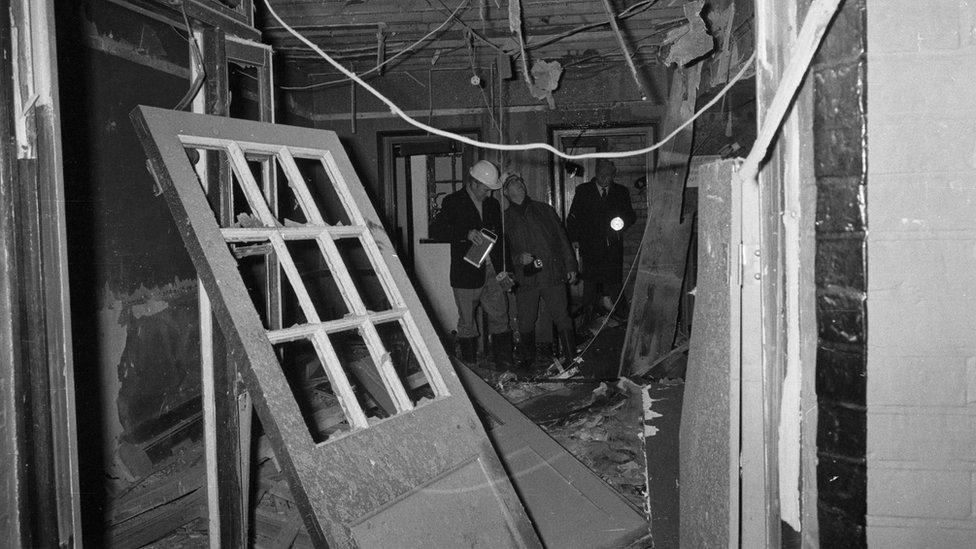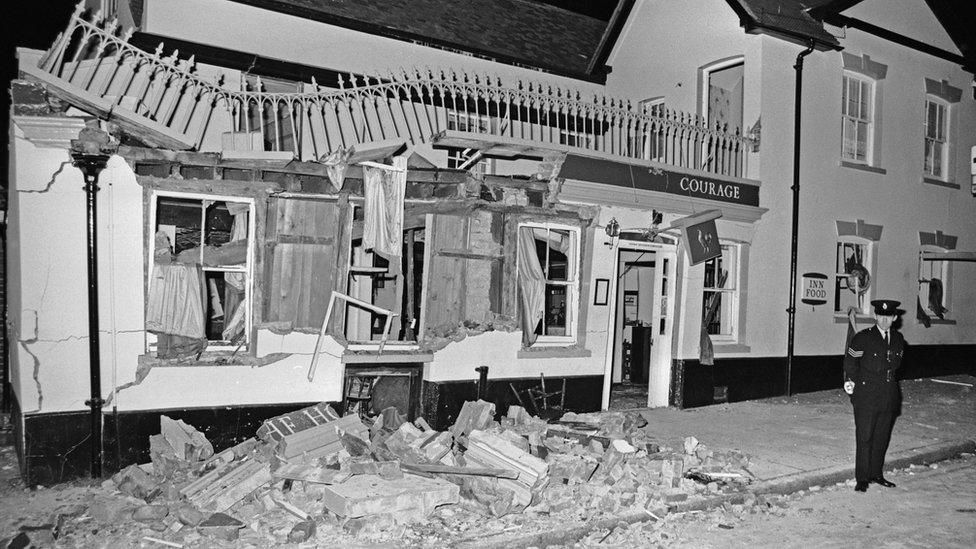Guildford pub bomb inquest: Soldiers 'aware of IRA threat'
- Published

Two pubs were bombed on 5 October 1974 - the Horse and Groom and the Seven Stars
Soldiers who died in the IRA bombing of a pub in Guildford in 1974 had been warned of the threat from the terrorist group, an inquest heard.
Former army officer Dr Gillian Boag-Munroe said soldiers in the Women's Royal Army Corps (WRAC) platoon which she led, were aware of the IRA's "fondness" for planting bombs.
The unit included two of the victims, Caroline Slater and Ann Hamilton.
Four soldiers and a civilian died in the attack, and 65 people were injured.
The Guildford Four and Maguire Seven were wrongly-convicted before the IRA claimed responsibility.
Dr Boag-Munroe, who was a 2nd Lieutenant, told the hearing that the Queen Elizabeth Barracks, where her platoon was based, "lived and breathed security".
She told Woking Coroner's Court: "Within the barracks there was no sense of insecurity. Outside the barracks, we were very aware the IRA had a fondness for planting car bombs and sending letter bombs."
She said soldiers were told to check under their cars and all mail arriving at the barracks was also checked. She also said recruits were told not to wear uniforms outside the base, which was located near Guildford.

Caroline Slater, 18, Ann Hamilton, 19, William Forsyth, 18, John Hunter, 17, and plasterer Paul Craig, 21, died in the first explosion at the Horse and Groom
The hearing also heard from Col Scott Innes, who is currently serving as principal staff officer responsible to regional command for delivery of security.
Col Innes, who joined the army in 1985, said an extensive search had been carried out for documents on security from 1974 but fewer than 5% of records now existed.
The inquest heard details of a letter in The National Archives that looked at a potential risk in 1974 from a soldier who deserted and joined the IRA in 1972.
The letter stated that the army security alert was "bikini black" and said the alert did not need to be raised.
Col Innes said bikini black was a normal level of alert, with higher levels of alert referred to as bikini black special, bikini amber and bikini red.
'Informed and educated'
An attack at Pirbright army base in 1973 had led to a newspaper report that nearly all army units in Britain had been put on a stricter security alert, the inquest heard.
Oliver Sanders QC, counsel to the inquest, asked if that meant the alert increased in 1973 but went back to bikini black by May 1974, five months before the Guildford attack took place.
Col Innes replied: "Potentially, yes, but there is nothing to confirm that."
Before the hearing, the family of Ms Hamilton questioned whether her barracks should have been locked down amid an ongoing IRA threat.
Col Innes said: "What you're looking to do is ensure service personnel are best informed and educated about any potential threat and what measures they should take to protect themselves."
Those who died in the bombing were 21-year-old civilian Paul Craig and soldiers Ms Hamilton, 19, Ms Slater, 18, William Forsyth, 18, and John Hunter, 17.
The inquest continues.

Follow BBC South East on Facebook, external, on Twitter, external, and on Instagram, external. Send your story ideas to southeasttoday@bbc.co.uk.
Related topics
- Published20 June 2022

- Published8 February 2022

- Published14 January 2022
